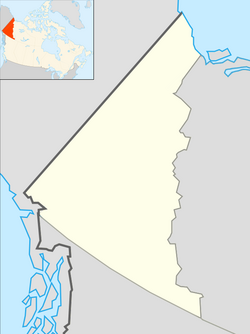Top Qs
Timeline
Chat
Perspective
Watson Lake, Yukon
Town in Yukon, Canada From Wikipedia, the free encyclopedia
Remove ads
Watson Lake is a town in Yukon, Canada, located at mile 635 on the Alaska Highway close to the British Columbia border. It had a population of 1,133 in 2021. The town is named for Frank Watson, an American-born trapper and prospector, who settled in the area at the end of the 19th century.[3]
Watson Lake is near the Liard River, at the junction of the Robert Campbell Highway and the Alaska Highway. The Stewart–Cassiar Highway's northern end is 22 km (14 mi) west of Watson Lake. The town is also served by the Watson Lake Airport; the airport was formerly served by Canadian Pacific Air Lines and other local and regional airlines, but now by Air North and corporate and charter services.
Watson Lake is the main centre of the small forestry industry in Yukon and has been a service centre for the mining industry, especially for the Cassiar, a now abandoned asbestos mine in northern British Columbia and the Cantung Mine, a tungsten mine on the Yukon-Northwest Territories border in the Mackenzie Mountains.
Tourist attractions in Watson Lake include the Northern Lights Centre[4] and the much-imitated original Sign Post Forest. The Sign Post Forest was started in 1942 by a homesick United States Army Corps of Engineers G.I. working on the Alaska Highway, who put up a sign with the name of his home town and the distance. Others followed suit and the tradition continues to this day. As of August 2010 there are more than 76,000 signs of various types depicting locations across the world. The Sign Post Forest is one of four roadside attractions featured on the first series of the Canadian Roadside Attractions Series issued by Canada Post on July 6, 2009.[5]
Watson Lake and the neighbouring Upper Liard settlement are the home of the Liard River First Nation, a member of the Kaska Dena Council. The Two Mile area immediately north of the core of town is a concentrated area of First Nations residents, while the town extends 8.0 km (5 mi) out to the turn-off of Airport Road. (Originally, Airport Road extended directly to the Alaska Highway, but most of it is now part of the Campbell highway.)
Remove ads
History
The Town of Watson Lake annexed Two Mile and Two and One-Half Mile Village on January 2, 2016.[6]
Geography
Summarize
Perspective
Climate
Like most of Yukon, Watson Lake has a subarctic climate (Dfc) with mild to warm summers and severely cold, snowy winters. Watson Lake experiences annual temperature average daily highs of 21.3 °C (70.3 °F) in July and average daily lows of −26.7 °C (−16.1 °F) in January. Record high temperature was 35.4 °C (95.7 °F) in July 2009 and the lowest was −58.9 °C (−74.0 °F) in January 1947. Watson Lake has more precipitation than other parts of Yukon with an average annual snowfall of 197.0 cm (77.56 in) and 260.9 mm (10.27 in) of rainfall, resulting in larger trees and a more viable forest industry.[7]
Remove ads
Demographics
Summarize
Perspective
In the 2021 Canadian census conducted by Statistics Canada, Watson Lake had a population of 1,133 living in 499 of its 564 total private dwellings, a change of 4.6% from its 2016 population of 1,083. With a land area of 109.77 km2 (42.38 sq mi), it had a population density of 10.3/km2 (26.7/sq mi) in 2021.[2]
Remove ads
Gallery
- Alaska Highway through Watson Lake
- Signpost forest at Watson Lake
- Ski Hill at Watson Lake
- Carmacks 583 kilometres
- Abandoned bulldozer
- Watson Lake Motors
See also
Notes
- Composite data from: Watson Lake A; Climate ID: 2101201; coordinates 60°06′59″N 128°49′21″W; elevation: 687.3 m (2,255 ft): Watson Lake (AUT); WMO ID: 71199; coordinates 60°06′57″N 128°49′55″W; elevation: 683.3 m (2,242 ft)
Remove ads
References
External links
Wikiwand - on
Seamless Wikipedia browsing. On steroids.
Remove ads









